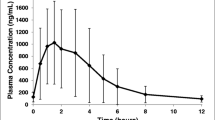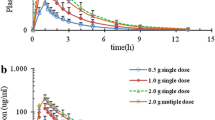Abstract
An open, parallel study was conducted to compare the pharmacokinetics of oral azithromycin in young and elderly healthy volunteers. A total of 12 young subjects (six males, six females) with a mean age of 29 (range 22–39) years and another 12 elderly subjects (six males, six females) with a mean age of 72 (range 67–80) years were given a standard five-day therapeutic regimen of azithromycin (500 mg single dose on day 1 and 250 mg once daily on days 2–5). Pharmacokinetic results indicated that Cmax, Cmin and urinary excretion were similar in the two age groups. Mean AUC0–24 was significantly greater (2.7 µg.h/ml) at day 5 in the elderly subjects compared with the younger age group (AUC0–24=2.1 µg.h/ml) (p=0.041). Similarly, tmax values on days 1 and 5 were significantly greater in the elderly subjects; 3.8 h compared with 2.5 h in young subjects (p=0.005) on day 1 and 4.4 h, compared with 3.2 h (p=0.047) on day 5. There was also evidence of an inverse relationship between creatinine clearance and AUC0–24 (p<0.01) but not urinary excretion or Cmax. Despite these observations, it is concluded that the differences between the two age groups were of insufficient magnitude to warrant a dose modification in elderly subjects with only mild renal impairment. Side effects, chiefly headache and gastrointestinal symptoms, were reported by seven subjects in each group. No subject, however, was withdrawn from the study and there were no treatment-related abnormalities in any of the laboratory parameters measured.
Similar content being viewed by others
References
Girard AE, Girard D, English AR, Gootz TD, Cimochowski CR, Faiella JA, Haskell SL, Retsema JA: Pharmacokinetic and in vivo studies with azithromycin (CP-62, 993) a new macrolide with an extended half-life and excellent tissue distribution. Antimicrobial Agents and Chemotherapy 1987, 3: 1948–1954.
Retsema JA, Girard AE, Girard D, Milisen WB: Relationship of high tissue concentrations of azithromycin to bactericidal activity and efficacy in vivo. Journal of Antimicrobial Chemotherapy 1990, 25, Supplement A: 83–89.
Retsema J, Girard A, Schelkly W, Manousos M, Anderson M, Bright G, Borovoy R, Brennan L, Mason R: Spectrum and mode of action of azithromycin (CP-62,993), a new 15-membered-ring macrolide with improved potency against gram-negative organisms. Antimicrobial Agents and Chemotherapy 1987, 31: 1939–1947.
Foulds G, Shepard RM, Johnson RB: The pharmacokinetics of azithromycin in human serum and tissues. Journal of Antimicrobial Chemotherapy 1990, 25, Supplement A: 73–82.
Cockcroft DW, Gault MH: Prediction of creatinine clearance from serum creatinine. Nephron 1976, 16: 31–41.
Author information
Authors and Affiliations
Rights and permissions
About this article
Cite this article
Coates, P., Daniel, R., Houston, A.C. et al. An open study to compare the pharmacokinetics, safety and tolerability of a multiple-dose regimen of azithromycin in young and elderly volunteers. Eur. J. Clin. Microbiol. Infect. Dis. 10, 850–852 (1991). https://doi.org/10.1007/BF01975839
Issue Date:
DOI: https://doi.org/10.1007/BF01975839




